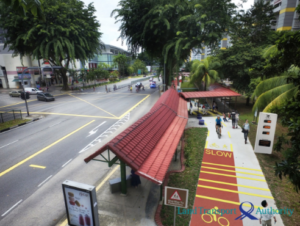
“Ang Mo Kio, one of the most established housing estates in Singapore has become the first ‘walking and cycling’ town. The first phase of the Ang Mo Kio Cycling network, which includes a 4km cycling path that loops around Ang Mo Kio Ave 1, 3 and 8 was officially opened on 9th July 2016. Cyclists are able to travel safely and seamlessly through the neighborhood to Ang Mo Kio MRT station, Ang Mo Kio Swimming Complex and the AMK Hub.
When fully completed in 2020, the cycling network in Ang Mo Kio will span 20km and will be the longest in any residential town. The cycling network will include a 2.6km-long walking and cycling corridor that runs along the MRT viaduct between Yio Chu Kang MRT station and Bishan-Ang Mo Kio Park.” (Source: Land Transport Authority)
“Jointly designed and developed by Land Transport Authority (LTA) and Urban Redevelopment Authority (URA), the walking and cycling town features are touted to be "pedestrian- and cyclist-friendly features". These include dedicated red-colored cycling paths to distinguish them from footpaths, rumble strips near bus stops to remind cyclists to slow down, and road crossings with safety features to reduce vehicle speeds and alert motorists to pedestrians and cyclists. Map boards have also been placed along the paths to help residents navigate the cycling network, the agencies said.
The unused space under the MRT viaduct along Ang Mo Kio Avenue 8 has been turned into a walking and cycling park with a large outdoor terrarium – with plans to build two more terrariums in future. Three MRT columns have also been decorated with artwork and there is a self-service station for cyclists to carry out basic maintenance on their bikes.
There are plans to build a play and fitness area and community gardening plots by 2019.
For phase two, an additional 16km-long cycling path network – including a 1.6km-long walking and cycling corridor along the MRT viaduct between Yio Chu Kang and Ang Mo Kio MRT stations – will be built.
The second phase will also feature an elevated walking and cycling path that will allow residents to walk and cycle more safely and conveniently to Ang Mo Kio MRT Station. The network will link up to the upcoming Mayflower and Lentor MRT stations on the Thomson-East Coast Line, as well as the cycling trunk route along the North-South Corridor, which offers a direct cycling connection from Ang Mo Kio to the city.
Road space at Ang Mo Kio Street 44 will be reconfigured to be more accommodating to pedestrians and cyclists and give them their own dedicated spaces, the agencies said, adding that secured bike parking facilities will be provided at the upcoming Thomson–East Coast Line stations in Ang Mo Kio to encourage cycling as a transport option to and from the train stations.
Works for the second phase will commence shortly and are expected to be completed in 2019, said the agencies. ‘When completed, the 20km-long cycling path network will be the longest in any residential town and all homes in the Ang Mo Kio HDB town will be within a 5-minute walk to the nearest cycling path,’ they said. ‘LTA will continue to work with the community and other agencies to replicate these features in other towns, so that more Singaporeans will be encouraged to take up active modes of transport like walking and cycling.’
Only about one per cent of all journeys within Ang Mo Kio Town are cycling journeys compared to 1.5 per cent of all journeys island-wide, according to Land Transport Authority (LTA) household surveys, but authorities say they are hoping to double or even triple this over the next five to 10 years.
Beyond changes to the infrastructure, some say making a walking and cycling town a reality is also about fostering such a culture as well.
‘With clarity on where the cycling paths are, they're all marked out in red with cycling logos, people will have more of a sense of assurance on where they can go,’ said LTA’s director of active mobility and fares Tan Shin Gee.
‘What we realized through some of our travel surveys is that a large majority of people choose to walk to the MRT station, but over time we think that with more extensive cycling path networks this can actually increase the reach, the coverage of our public transport network.’
Pragash Kulasagar, who leads an Active Mobility Patrol team in Teck Ghee, adds that it is also about encouraging a change in mindset for cyclists. As part of the LTA Active Mobility scheme, Mr Kuasagar and 110 grassroots leaders and volunteers patrol cycling hotspots and educate cyclists on proper etiquette.
‘I was at the bus stop, and I saw one cyclist – the bus arrived and people are boarding the bus, and this cyclist just wanted to bash through by ringing his bell,’ the 50-year-old said. ‘I stopped him, and he was not happy and just cycled off.’
‘(A change in mindset) I think cannot happen overnight, but we are truly trying our best to engage the residents and educate them.’” (Source: Channel News Asia)